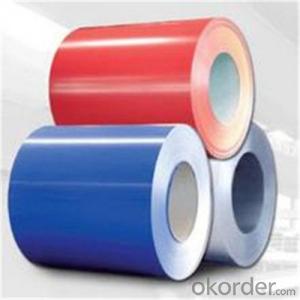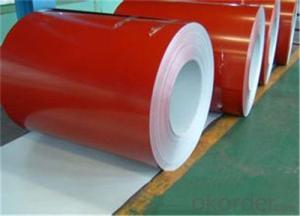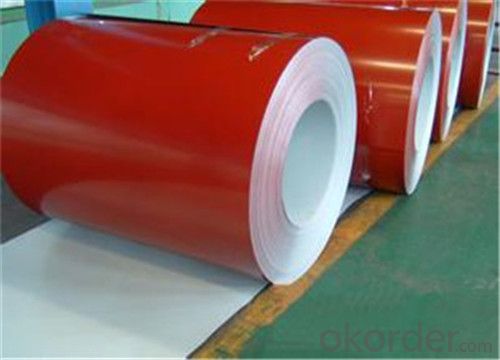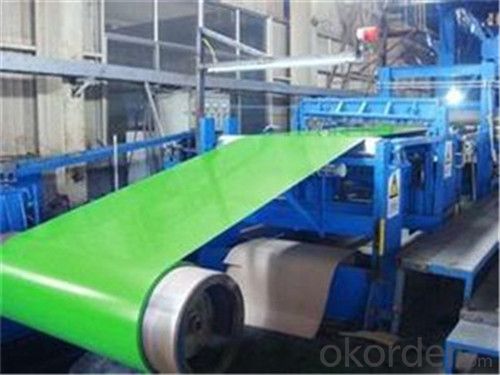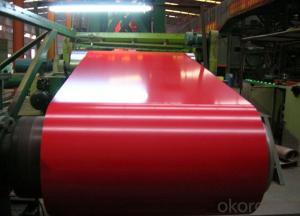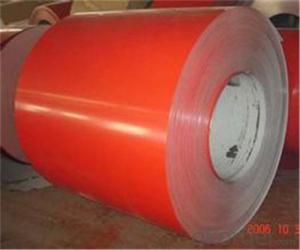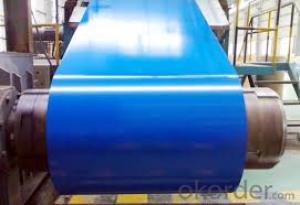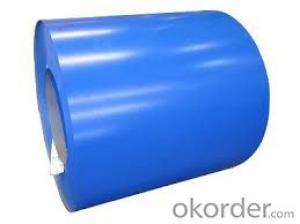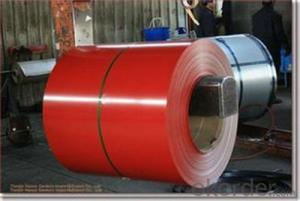Colored Galvanized Rolled Steel Coil/Sheet from China
- Loading Port:
- Tianjin
- Payment Terms:
- TT OR LC
- Min Order Qty:
- 100 m.t.
- Supply Capability:
- 500000 m.t./month
OKorder Service Pledge
OKorder Financial Service
You Might Also Like
Description of Prepainted Galvanized Steel:
1.material : galvanized steel sheet / prepainted galvanized sheet
2.sheet thickness : normal use 0.3-0.6mm
3.length: any length, according to the transportation, generally less than 12m
4.color: standard color: red, blue, white, grey; special color: according to RAL color
Specification of Prepainted Galvanized Steel:
Thickness:0.15mm-1.2mm
Width:600mm-1250mm
Coil ID:508mm/610mm
Base Metal: GI/GL.
Zinc Coating:30-275 G/M2
Paint Coating: Top 30; Back 5-7. Or up to Buyer’s Option.
With Protection Film or Without Protection Film.
Spangle: Regular Spangle, Small Spangle, Zero Spangle.
Coil Weight:3-5MT or Customized Weight.
Delivery:15-25 days
MOQ:25MT
Color: RAL Color Series or Customized Colors.
Temper: Commercial Quality G 350; Structural Quality: G550; Full Hard.
Charactics of Prepainted Galvanized Steel
It can be widely used in transportation, light industry, civil usage and farming. It is also the perfect building material in construction for making steel roofing, insulation panel, corrugate sheet, facade wall, shutters, T-bar and home appliance.
Images of Prepainted Galvanized Steel:
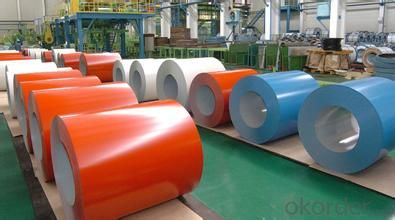
FAQ
1.What's your MOQ?
25MT, it is for one container.
2.Do you have QC teams?
Yeah, sure, our QC team is very important, they will keep the quality control for our products
- Q: I'm trying to bend stainless steel spoons, forks knives etc. for an art project. Will heating them help bend them into certain shapes or will heat only strengthen it? What is the best way to bend stainless steel?
- We are regular buyers of such bends.
- Q: What are the different coil leveling machine configurations used for steel coils?
- Steel coils can be processed using various coil leveling machine configurations, each designed to meet specific requirements. One commonly used configuration is the four-high leveling machine, consisting of a stack of four leveling rolls. These rolls apply pressure to flatten and level the steel coil. This configuration is ideal for thicker and heavier coils, as it offers greater pressure and control. Another option is the six-high leveling machine, which comprises two stacks of three leveling rolls each. The steel coil passes through the first stack for initial leveling and then through the second stack for further refinement. This configuration is suitable for thinner coils, allowing for a more precise and gentle leveling process. Additionally, combination leveling machines are available, integrating leveling with other processes like slitting or shearing. These machines provide a comprehensive solution for steel coil processing, particularly in applications requiring multiple steps to achieve the desired final product. Choosing the right coil leveling machine configuration depends on factors such as coil thickness, weight, desired precision, and efficiency. Manufacturers and processors must carefully assess their specific needs to select the appropriate configuration, ensuring optimal results in the steel coil leveling process.
- Q: What are the different methods of recoiling steel coils?
- There are several methods used for recoiling steel coils, depending on the specific requirements and characteristics of the material. Some of the common methods include: 1. Slitting: This method involves cutting the steel coil into narrower strips, which can then be recoiled. Slitting is typically done using rotary knives or circular saws, and it allows for precise width control. 2. Rewinding: This method involves unwinding the steel coil and then rewinding it onto a new coil mandrel. It is commonly used when the original coil needs to be resized, or when the coil has become damaged and needs to be reconditioned. 3. Recoiling with a tension control system: In this method, the steel coil is passed through a set of tension control rollers, which apply a controlled amount of tension to the material. This allows for a smooth and even recoiling process, minimizing the risk of coil distortion or damage. 4. Recoiling with a slitter head: This method combines the slitting and recoiling processes into a single operation. A slitter head is used to simultaneously cut the steel coil into narrower strips and rewind them onto separate coils. 5. Recoiling with a looping pit: In this method, the steel coil is fed through a looping pit, which allows for the accumulation of material as the coil is recoiled. This helps to maintain a consistent line speed and tension during the recoiling process. Each of these methods has its own advantages and is suitable for different applications. The choice of recoiling method depends on factors such as the desired coil dimensions, the material's thickness and strength, and the required level of precision and quality.
- Q: I've heard on some 1911 forums that the slides of Armscor guns are now extruded. What is extruded steel? How is it made? Are they strong (4140carbon steel was used in the process).
- Extruded steel is only the steel being run through a die when it is heated, it usually reduces the size of the grain of the steel itself, enhancing toughness. Realistically though, in a handgun, it doesn't matter if the frame is cast or forged, both types will hold up to any amount of abuse, unless you use it as a sledgehammer, and are splitting stones with it, then the forged frame would win. 4140 is more than adequate for a slide/frame. Hell, even mild steel would be adequate as long as you don't mind some dings and scratches, and again, don't use it as a sledgehammer...
- Q: How can the outer diameter and weight of steel coil be converted?
- Of course, the calculation is relatively coarse, and the volume has a lot to do with the tension.
- Q: How are steel coils stored to prevent damage?
- In order to prevent damage and maintain their integrity, steel coils are stored in a manner that is designed to minimize risks. One common approach involves horizontally stacking the coils, which helps evenly distribute the weight and reduces the likelihood of deformation or damage. Additionally, each layer of coils is often separated by wooden or steel dunnage to provide support and prevent shifting during storage or transportation. To protect the coils from harm, they are frequently stored indoors or in covered areas to shield them from exposure to the elements. This precaution serves to prevent rusting or corrosion, which could compromise the steel's quality. In situations where outdoor storage is necessary, weather-resistant tarps or protective coatings may be used to minimize the potential impact of rain, snow, or sunlight. Moreover, it is essential to consider the height at which the coils are stacked in order to avoid applying excessive pressure on the lower coils. To prevent damage, coils are typically stacked in a manner that ensures the weight from the upper layers is evenly distributed across the lower ones. This may involve the utilization of specialized stacking equipment or racks that are specifically designed to handle the weight and dimensions of the coils. In summary, the proper storage of steel coils entails careful attention to weight distribution, protection from the elements, and minimizing contact between coils to prevent damage and preserve their quality.
- Q: How are steel coils used in the manufacturing of industrial valves?
- Steel coils are used in the manufacturing of industrial valves as they are processed and formed into various valve components, such as bodies, flanges, and stems. These coils are cut, shaped, and welded to create the necessary parts that make up the valve, ensuring its strength, durability, and functionality in industrial applications.
- Q: Which of the two are better for exhaust manifolds, im guessing the stainless steel right?
- Cast iron. That's what OEMs use obviously it's better. Bring on the Thumbs Down from the peanut gallery.
- Q: What are the dimensions of steel coils used in the packaging industry?
- The dimensions of steel coils utilized in the packaging industry are subject to variation in accordance with the specific application and requirements. However, the customary dimensions for steel coils employed in packaging encompass a thickness ranging from 0.15 mm to 3 mm and a width spanning from 600 mm to 2000 mm. The internal diameter of the coil, referred to as the core, generally measures around 508 mm (20 inches); however, alternative sizes such as 610 mm (24 inches) or 762 mm (30 inches) may also be utilized. The outer diameter of the coil may fluctuate contingent upon the weight and size of the coil, yet it commonly falls between 1000 mm and 2000 mm. It is crucial to emphasize that these dimensions can be tailored to accommodate the specific requirements and preferences of the packaging industry.
- Q: Search the internet for 'Frost Clipper Knife'. This knife comes in either stainless or carbon steel. I have a friend who has one (stainless steel) and he is very impressed with it, but I have heard that Carbon Steel blades are better? Discuss...
- There are different grades of Carbon Steel. A good grade is much harder than Stainless Steel and will stay sharp longer. It is also many times harder to get an edge on than Stainless Steel. I have had both and prefer the Stainless Steel because eventually the Carbon Blade does get dull, and you will wear out a Whet Stone trying to put the edge back on it. The Stainless Steel holds an edge an acceptable amount of time and is easier to sharpen when the time comes. Putting either knife through a can opener sharpener will ruin the edge and make it almost impossible to put another edge on the knife. Look closely and determine the angel of the bevel, then lay the knife bevel flat on a good whet stone and try to take a thin slice off of the stone. Turn the knife over and do the other side so you keep the edge centered on the blade. Keep turning the knife over and taking thin slices until it is sharp. Dress with a good quality sharpening steel.
Send your message to us
Colored Galvanized Rolled Steel Coil/Sheet from China
- Loading Port:
- Tianjin
- Payment Terms:
- TT OR LC
- Min Order Qty:
- 100 m.t.
- Supply Capability:
- 500000 m.t./month
OKorder Service Pledge
OKorder Financial Service
Similar products
Hot products
Hot Searches
Related keywords
